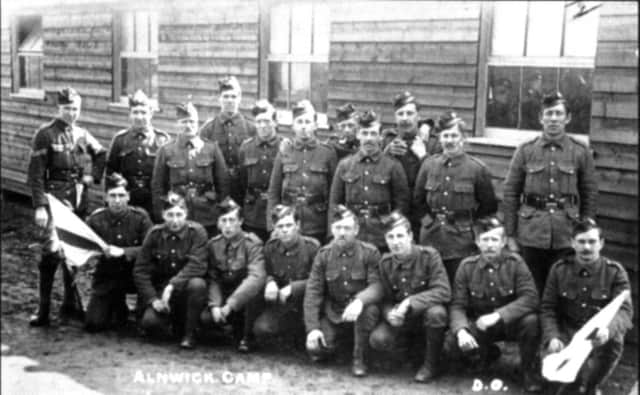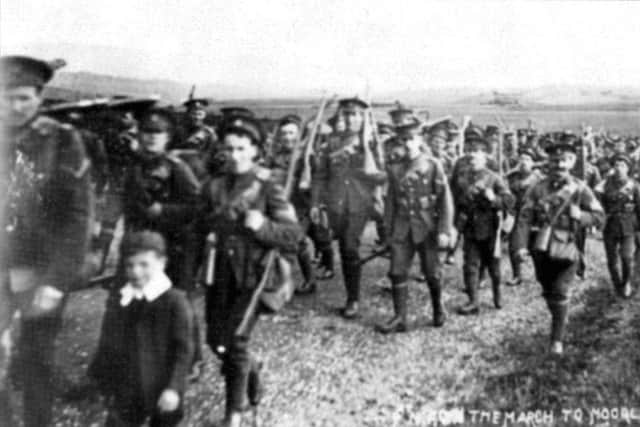Group helped mark centenary of the Great War '“ part two


Despite the group’s project now being completed, its internet presence will continue to be maintained in the foreseeable future so as to give access to people and community groups to the search database, and schools access to the teaching resources portal.
David Thompson, IT/search database project manager, said: “The search database has been central to our internet presence, indeed the principal reason for it.
Advertisement
Hide AdAdvertisement
Hide Ad

“The idea for it originated long before the project group was formally constituted because, even then, masses of data was already available from private researches conducted by Western Front Association (WFA) branch.
“Dudley George, Bailiffgate Museum’s webmaster, must be credited for compiling the first three versions of the database using information supplied by several local WFA members. The database had grown to cover about 600 casualties by the time the group assumed total responsibility for it from May 2013.”
Work has recently been completed on version 10 of the database, which has expanded to almost 1,100 casualties. The local WFA branch will be taking responsibility for its further development.
Another two revisions are expected during 2016 although the total number of casualties included is unlikely to change much. The branch simply envisages adding more data and, especially, photographs for some of those men already included on the database.


Heritage trail showcases sites controlled by War Department
Advertisement
Hide AdAdvertisement
Hide AdHeritage Trail leaflet – Alnwick in the Great War: Running concurrently with the schools and education element of the project, and an integral part of it, was production of a heritage trail leaflet, Alnwick in the Great War, which focused on some of the 50 or more buildings and parcels of land in the area which are known to have been in the occupation of the War Department on June 1, 1918.
They were used for accommodating troops, aerodromes, hospitals, offices, rifle ranges, stores and training grounds, among other things.
More than 5,000 copies of the leaflet were produced – 500 were distributed to schools, 4,000 were distributed in three waves in shops, local amenities, Bailiffgate Museum and the Tourist Information Centre and the remaining 500 to 1,000 were held back for use in relation to The March commemoration events over the weekend of January 31 to February 1, 2015.
Memories of the Great War exhibition: Another important part of the heritage element of the project was the Memories of the Great War exhibition at Bailiffgate Museum which ran from March 31 to May 17 last year.
Advertisement
Hide AdAdvertisement
Hide AdMo Dewarm, group member, said: “It was a bit out of the ordinary in that we had memorabilia, with explanatory notes, in respect of two families – one of which had four ancestors to remember – but also exhibits relating to two village communities.
“One, Hauxley, was a fishing, agricultural and coal mining community at the time of the First World War, while the other, Howick, is best described as an estate village because at the core of it is an ancestral seat of the Earls Grey.”
These village exhibits covered more than the fighting men. There were facts about the communities at the time and some home front activities including nursing wounded soldiers. It attracted about 900 visitors to the museum.
Howick Heritage Group publication: Howick Heritage Group later mounted the exhibition they had used at the museum together with other research data collected but not displayed, all round the walls of Howick Church where it would be seen by visitors.
Advertisement
Hide AdAdvertisement
Hide AdAn approach to the Alnwick District WW1 Centenary Commemoration Group to help them publish illustrated stories gathered in a book for free distribution to Howick residents, local schools and libraries, Northumberland Records Office at Woodhorn, Bailiffgate Museum and local churches met with a positive response. 80 copies of the 45-page book have been published with 55 delivered to each Howick household.
Heritage talks: In addition to the regular speaker programme organised by WFA’s Northumberland Branch, other heritage talks have been delivered to community groups.
WFA meetings take place at 7.15pm (for 7.30pm) on the fourth Monday of every month at Alnmouth & District Ex-Serviceman’s Club & Institute, Northumberland Street, Alnmouth.
A warm welcome awaits visitors and WFA members new to the branch.
Advertisement
Hide AdAdvertisement
Hide AdInquiries should be directed to Dave Barras, speaker secretary ([email protected]; 01670 760809) or Neil Brison, chairman (01665 602349).
Books shed further light on local experience of war
In addition to underwriting Howick Heritage Group’s book, the group contributed to publication of two other books – Alnwick in the Great War, by Ian Hall, and Me, the RAF and 77 Squadron, the memoirs of Bill Foote, DFC, a Halifax Bomber pilot in the Second World War and a member of the group.
Published at the end of July 2014 and proudly carrying the WFA’s logo on the front cover, acknowledging the part Northumberland Branch played in its conception and publication, Alnwick in the Great War is notable for a fascinating collection of facts, many never-before-published photos and facsimiles concerning Alnwick Camp, some of the Northumberland Fusiliers’ battalions stationed there and about the wider Alnwick district.
The facsimiles of papers bought by Kevin Barron at a Liverpool auction reveal the innermost workings of the Local Emergency Committees in the area.
Advertisement
Hide AdAdvertisement
Hide AdThis is a unique insight into the home defence preparations. Such home defence matters are more usually associated with the Second World War, but this book shows that much of the planning – and practice – had been carried out many years before and had begun to be implemented within days of the declaration of war in 1914.
As one of the founding members of the group, Bill Foote, DFC, found a way of contributing to the project’s success through publication, in August 2014, of his memoirs as a young Bomber Command pilot during the Second World War – Me, the RAF and 77 Squadron.
Publication was timed to coincide with the 70th anniversary of his first operational flight over German-occupied mainland Europe.
Respectively priced at £4.50 and £7.50, including packing and postage in the UK, copies of both books are still available from Wanney Books at www.wildsofwanney.co.ukGeographical extent of project spread
Advertisement
Hide AdAdvertisement
Hide AdWhen reflecting on building the search database, David Thompson added: “Perhaps the only surprising thing about our project has been how, in practice, the original intention to focus on the
communities and places within what was the old Alnwick District Council geographical area has slowly extended to embrace more of north Northumberland, but not quite all of it!”
Geographically, the project focused on communities and places within an area bounded by Bamburgh in the north, west to Kirknewton and Wooler, then south-west to Coquetdale, turning south-east to Longframlington and east via West and East Chevington to the coast at the northern end of Druridge Bay.